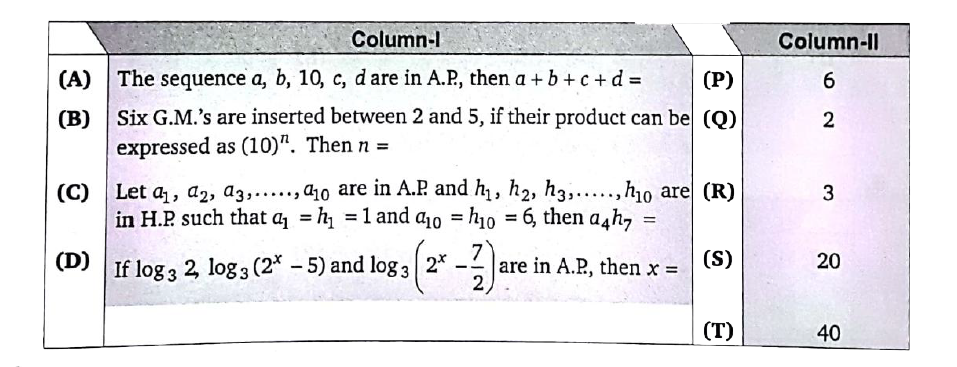Given that sequence of number a1,a2,a3,……,a1005 which satisfy a1a1+1=a2a2+3=a3a3+5=……=a1005a1005+2009
a1+a2+a3.......a1005=2010 find the 21st term of the sequence is equal to :
861065
831005
821005
791005
The correct Answer is:C
Step by step video solution for Given that sequence of number a _(1), a _(2) , a_(3),……, a _(1005) which satisfy (a_(1))/( a _(1)+ 1) =(a_(2))/(a _(2) +3) = (a _(3))/(a _(3)+5) = …… = (a _(1005))/(a _(1005)+2009) a_1+a_2+a_3.......a_(1005)=2010 find the 21^(st) term of the sequence is equal to : by Maths experts to help you in doubts & scoring excellent marks in Class 12 exams.
Updated on:21/07/2023Topper's Solved these Questions
- SEQUENCE AND SERIES Book:VIKAS GUPTA (BLACK BOOK) ENGLISHChapter:SEQUENCE AND SERIES Exercise:EXERCISE (MATCHING TYPE PROBLEMS)
Explore 4 Videos
- SEQUENCE AND SERIES Book:VIKAS GUPTA (BLACK BOOK) ENGLISHChapter:SEQUENCE AND SERIES Exercise:EXERCISE (SUBJECTIVE TYPE PROBLEMS)
Explore 21 Videos
- SEQUENCE AND SERIES Book:VIKAS GUPTA (BLACK BOOK) ENGLISHChapter:SEQUENCE AND SERIES Exercise:EXERCISE (ONE OR MORE THAN ONE ANSWER IS/ARE CORRECT)
Explore 19 Videos
- QUADRATIC EQUATIONS Book:VIKAS GUPTA (BLACK BOOK) ENGLISHChapter:QUADRATIC EQUATIONS Exercise:EXERCISE (SUBJECTIVE TYPE PROBLEMS)
Explore 45 Videos
- SOLUTION OF TRIANGLESBook:VIKAS GUPTA (BLACK BOOK) ENGLISHChapter:SOLUTION OF TRIANGLESExercise:Exercise-5 : Subjective Type Problems
Explore 11 Videos
Similar Questions

View SolutionLet a,b,c,d be four distinct real number in A.P.Then the smallest positive vlaue of k satisfying 2(a−b)+k(b−c)2+(c−a)3=2(a−d)+(b−d)2+(c−d)3is_________
View Solutionabout to only mathematics
View SolutionLet f(x)=ax2+bx+c where a,b,c are integers. If sinπ7.sin3π7+sin5x7+sin5π7sin5π7+sinπ7=f(cosπ7), then find the value of f(2):
View SolutionIf the median AD of triangle ABC makes an angle π4 with the side BC, then find the value of |cotB−cotC|.
View SolutionThe sequence a_(1),a_(2),a_(3),a_(4)...... satisfies a_(1)=1,a_(2)=2 and a_(n+2)=(2)/(a_(n+1))+a_(n),n=1,2,3... If 2^(lambda)a_(2012)=(2011!)/((1005!)^(2)) then lambda is equal to
View SolutionGiven the sequence of numbers x_(1),x_(2),x_(3),...x_(1005) which satisfy x_(2)(x_(1))/(x_(1)+1)=(x_(2))/(x_(2)+3)=(x_(3))/(x_(3)+5)=...=(x_(1005))/(x_(1005)+2009) Also,x_(1)+x_(2)+...x_(1005)=2010. Nature of the sequence is
View SolutionA geometric sequence has four positive terms a_(1),a_(2),a_(3),a_(4). If (a_(3))/(a_(1))=9 and a_(1)+a_(2)=(4)/(3) then a_(4) equals
View SolutionIf a_(n) is a geometric sequence with a_(1)=2 and a_(5)=18, then the value of a_(1)+a_(3)+a_(5)+a_(7) is equal to
View SolutionGiven that sequence of number a1,a2,a3,……,a1005 which satisfy a1a1+1=a2a2+3+a3a3+5=……=a1005a1005+2009
a1+a2+a3.......a1005=2010 find the 21st term of the sequence is equal to :
View SolutionA sequence of real numbers a1,a2,a3,......an+1 is such that a1=0,|a2|=|a1+1|,|a3|=|a2+1| Then a1+a2+.........+ann cannot be equal to.
View SolutionIf the sequence a1,a2,a3,…….. Is an A.P., then the sequence a5,a10,a15,…….. Is ………..
View SolutionGiven the sequence of numbers x1,x2,x3,x4......x1005 which satisfy x1x1+1=x2x2+3=x3x3+5=...=x1005x1005+2009 Also x1+x2+x3+......x1005=2010,, 21st term of the sequence is equal to
View SolutionThe Fibonacci sequence is defined by 1=a1=a2 and an=an−1+an−2,n>2. Find an+1an,for n = 1, 2, 3, 4, 5.
View SolutionIf a1,a2,a3,... are in A.P. and ai>0 for each i, then n∑i=1na23i+1+a13i+1a13i+a23i is equal to (a) na2/3n+a1/3n+a2/31 (b) n(n+1)a2/3n+a1/3n+a2/31 (c) n(n−1)a2/3n+a1/3n⋅a1/31+a2/31 (d) None of these
View SolutionThe Fibonacci sequence is defined by 1=a1=a2 and an=an−1+an−2, n>2. Find an+1an , for n = 1, 2, 3, 4, 5
View Solution
